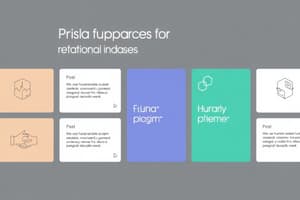Podcast
Questions and Answers
What is the primary focus of human-centered design?
What is the primary focus of human-centered design?
- Creating innovative and technologically advanced products
- Meeting business goals and objectives
- Reducing development costs and time
- Understanding the needs, desires, and limitations of humans (correct)
Which of the following is NOT a key principle of human-centered design?
Which of the following is NOT a key principle of human-centered design?
- Co-creation
- Empathy
- Automation (correct)
- User research
What is the primary goal of the 'empathize' stage in the human-centered design process?
What is the primary goal of the 'empathize' stage in the human-centered design process?
- To define the problem or opportunity
- To create a prototype or mockup
- To understand the user's needs and pain points (correct)
- To generate ideas and solutions
What is a benefit of using human-centered design?
What is a benefit of using human-centered design?
What is a challenge of implementing human-centered design?
What is a challenge of implementing human-centered design?
What is the purpose of the 'test' stage in the human-centered design process?
What is the purpose of the 'test' stage in the human-centered design process?
Why is it important to involve users in the design process through co-creation?
Why is it important to involve users in the design process through co-creation?
What is a result of balancing business goals with user needs in human-centered design?
What is a result of balancing business goals with user needs in human-centered design?
Flashcards are hidden until you start studying
Study Notes
Human-Centered Design in UX
Definition
- Human-centered design is an approach to design that focuses on understanding the needs, desires, and limitations of humans to create products that are intuitive, easy to use, and meet their needs.
Key Principles
- Empathy: Understanding the user's perspective and feelings to design solutions that meet their needs.
- User research: Conducting research to gather data and insights about the user's behaviors, motivations, and goals.
- Co-creation: Involving users in the design process to gather feedback and iterate on solutions.
- Iteration: Continuously refining and improving the design based on user feedback and testing.
Human-Centered Design Process
- Empathize: Understand the user's needs and pain points through research and analysis.
- Define: Define the problem or opportunity to be addressed.
- Ideate: Generate ideas and solutions based on user needs.
- Prototype: Create a prototype or mockup of the solution.
- Test: Test the solution with users to gather feedback and iterate.
Benefits of Human-Centered Design
- Improved user experience: Designs that meet user needs and expectations lead to higher satisfaction and engagement.
- Increased user adoption: Designs that are intuitive and easy to use lead to higher adoption rates.
- Competitive advantage: Human-centered design can differentiate a product or service from competitors.
- Cost savings: Identifying and addressing user needs early on can reduce development costs and time.
Challenges of Human-Centered Design
- Time and resource constraints: Human-centered design requires significant time and resources for research and testing.
- Balancing business goals with user needs: Designers must balance business goals with user needs, which can be challenging.
- Stakeholder buy-in: Getting stakeholders to buy into the human-centered design approach can be difficult.
- Measuring success: It can be challenging to measure the success of human-centered design, as it requires long-term evaluation.
Human-Centered Design in UX
Definition
- Human-centered design focuses on understanding human needs, desires, and limitations to create intuitive and easy-to-use products.
Key Principles
Empathy
- Understanding the user's perspective and feelings to design solutions that meet their needs.
User Research
- Conducting research to gather data and insights about user behaviors, motivations, and goals.
Co-creation
- Involving users in the design process to gather feedback and iterate on solutions.
Iteration
- Continuously refining and improving the design based on user feedback and testing.
Human-Centered Design Process
Empathize
- Understand user needs and pain points through research and analysis.
Define
- Define the problem or opportunity to be addressed.
Ideate
- Generate ideas and solutions based on user needs.
Prototype
- Create a prototype or mockup of the solution.
Test
- Test the solution with users to gather feedback and iterate.
Benefits of Human-Centered Design
- Designs that meet user needs and expectations lead to higher satisfaction and engagement.
- Designs that are intuitive and easy to use lead to higher adoption rates.
- Human-centered design can differentiate a product or service from competitors.
- Identifying and addressing user needs early on can reduce development costs and time.
Challenges of Human-Centered Design
- Human-centered design requires significant time and resources for research and testing.
- Designers must balance business goals with user needs.
- Getting stakeholders to buy into the human-centered design approach can be difficult.
- It can be challenging to measure the success of human-centered design, requiring long-term evaluation.
Studying That Suits You
Use AI to generate personalized quizzes and flashcards to suit your learning preferences.




